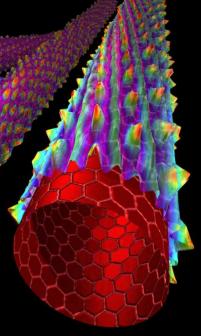If an electron is confined to a very small space, its quantum nature becomes dominant and the classical laws of motion break down. A variety of structures are currently being explored in universities and industry for a range of applications and interesting physics at the nanoscale. The laser in your CD player is a good example of a very successful quantum system exploiting one-dimensional confinement. Being able to map out ultrafast dynamics is an extremely powerful way of seeing a nanostructure in action. Light is a versatile tool since it allows access to these tiny quantum players without requiring complicated electrical contacts or destructive probing.
A particular intriguing nanostructure is the carbon nanotube. Here nature works for the researcher to grow an atomically perfect quantum system in which electrons are confined in two-dimensions. The quantum confinement dramatically alters the properties of the system, giving it some unheralded characteristics: the electrical conductivity of copper, the thermal conductivity of diamond, all packaged in something the size of a DNA molecule. It has even been found that a single nanotube can emit light (try doing that with the carbon graphite in your pencil!). Novel ultrafast dynamics and nonlinear optical properties are also determined by the quantum nature of the system and are only now being understood.

 The Physics Department
The Physics Department